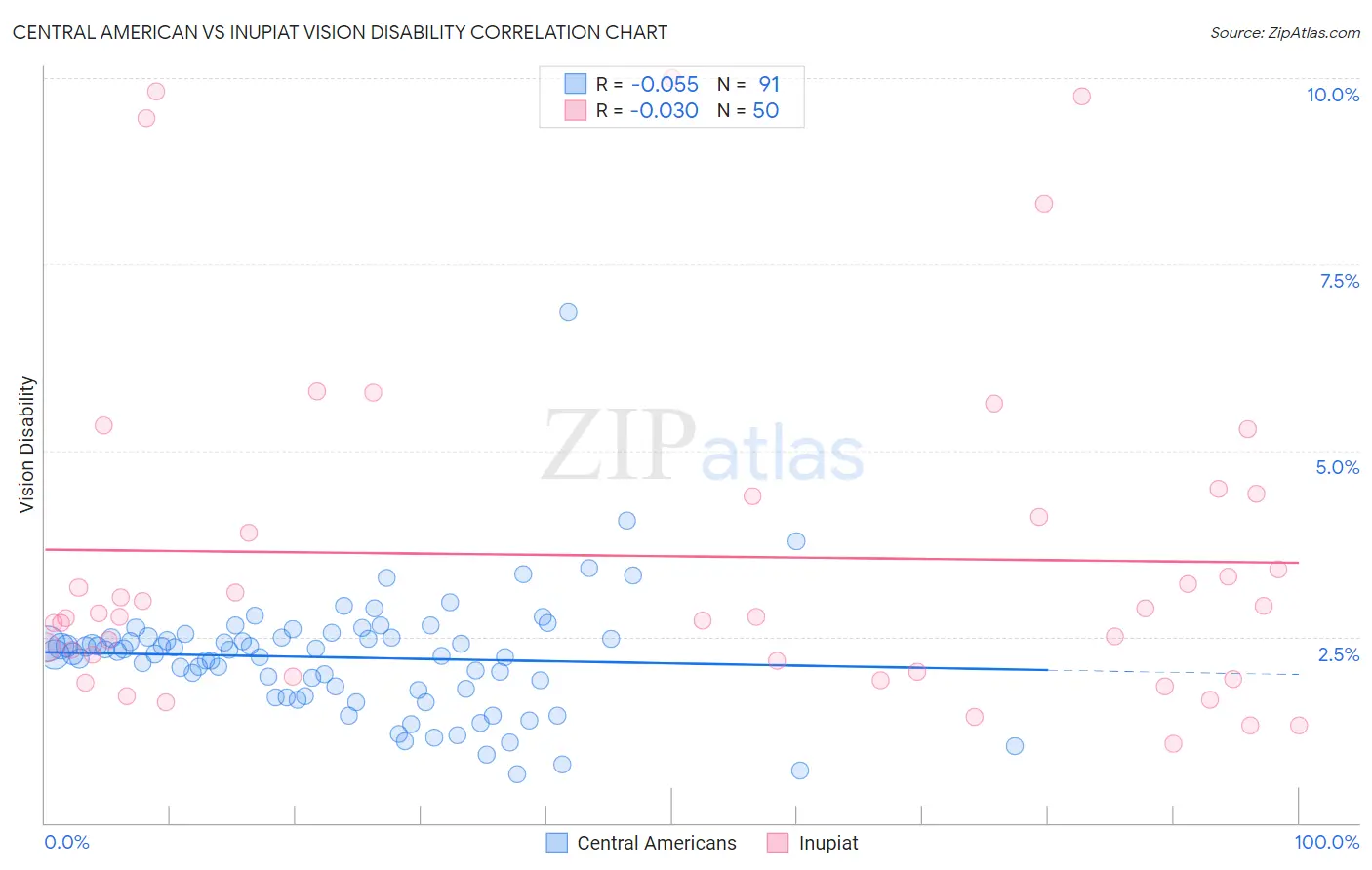Central American vs Inupiat Vision Disability
COMPARE
Central American
Inupiat
Vision Disability
Vision Disability Comparison
Central Americans
Inupiat
2.3%
VISION DISABILITY
1.8/ 100
METRIC RATING
233rd/ 347
METRIC RANK
2.7%
VISION DISABILITY
0.0/ 100
METRIC RATING
314th/ 347
METRIC RANK
Central American vs Inupiat Vision Disability Correlation Chart
The statistical analysis conducted on geographies consisting of 503,926,566 people shows a slight negative correlation between the proportion of Central Americans and percentage of population with vision disability in the United States with a correlation coefficient (R) of -0.055 and weighted average of 2.3%. Similarly, the statistical analysis conducted on geographies consisting of 96,318,866 people shows no correlation between the proportion of Inupiat and percentage of population with vision disability in the United States with a correlation coefficient (R) of -0.030 and weighted average of 2.7%, a difference of 15.0%.

Vision Disability Correlation Summary
| Measurement | Central American | Inupiat |
| Minimum | 0.66% | 1.1% |
| Maximum | 6.9% | 10.0% |
| Range | 6.2% | 8.9% |
| Mean | 2.2% | 3.6% |
| Median | 2.3% | 2.8% |
| Interquartile 25% (IQ1) | 1.8% | 2.0% |
| Interquartile 75% (IQ3) | 2.5% | 4.4% |
| Interquartile Range (IQR) | 0.71% | 2.4% |
| Standard Deviation (Sample) | 0.81% | 2.3% |
| Standard Deviation (Population) | 0.81% | 2.3% |
Similar Demographics by Vision Disability
Demographics Similar to Central Americans by Vision Disability
In terms of vision disability, the demographic groups most similar to Central Americans are German Russian (2.3%, a difference of 0.020%), Scottish (2.3%, a difference of 0.18%), Immigrants from Ecuador (2.3%, a difference of 0.20%), Marshallese (2.3%, a difference of 0.25%), and Immigrants from Congo (2.3%, a difference of 0.34%).
| Demographics | Rating | Rank | Vision Disability |
| Immigrants | Germany | 3.0 /100 | #226 | Tragic 2.3% |
| Hawaiians | 2.9 /100 | #227 | Tragic 2.3% |
| Hmong | 2.5 /100 | #228 | Tragic 2.3% |
| Welsh | 2.3 /100 | #229 | Tragic 2.3% |
| Nicaraguans | 2.2 /100 | #230 | Tragic 2.3% |
| Immigrants | Ecuador | 2.0 /100 | #231 | Tragic 2.3% |
| German Russians | 1.8 /100 | #232 | Tragic 2.3% |
| Central Americans | 1.8 /100 | #233 | Tragic 2.3% |
| Scottish | 1.6 /100 | #234 | Tragic 2.3% |
| Marshallese | 1.5 /100 | #235 | Tragic 2.3% |
| Immigrants | Congo | 1.4 /100 | #236 | Tragic 2.3% |
| Immigrants | Portugal | 1.4 /100 | #237 | Tragic 2.3% |
| Immigrants | Cambodia | 1.1 /100 | #238 | Tragic 2.3% |
| English | 1.1 /100 | #239 | Tragic 2.3% |
| Panamanians | 0.9 /100 | #240 | Tragic 2.3% |
Demographics Similar to Inupiat by Vision Disability
In terms of vision disability, the demographic groups most similar to Inupiat are Potawatomi (2.6%, a difference of 0.070%), American (2.6%, a difference of 0.080%), Dominican (2.6%, a difference of 0.91%), Blackfeet (2.6%, a difference of 0.95%), and Osage (2.7%, a difference of 1.2%).
| Demographics | Rating | Rank | Vision Disability |
| Immigrants | Dominican Republic | 0.0 /100 | #307 | Tragic 2.6% |
| Arapaho | 0.0 /100 | #308 | Tragic 2.6% |
| Immigrants | Yemen | 0.0 /100 | #309 | Tragic 2.6% |
| Blackfeet | 0.0 /100 | #310 | Tragic 2.6% |
| Dominicans | 0.0 /100 | #311 | Tragic 2.6% |
| Americans | 0.0 /100 | #312 | Tragic 2.6% |
| Potawatomi | 0.0 /100 | #313 | Tragic 2.6% |
| Inupiat | 0.0 /100 | #314 | Tragic 2.7% |
| Osage | 0.0 /100 | #315 | Tragic 2.7% |
| Shoshone | 0.0 /100 | #316 | Tragic 2.7% |
| Yup'ik | 0.0 /100 | #317 | Tragic 2.7% |
| Alaska Natives | 0.0 /100 | #318 | Tragic 2.7% |
| Tohono O'odham | 0.0 /100 | #319 | Tragic 2.8% |
| Blacks/African Americans | 0.0 /100 | #320 | Tragic 2.8% |
| Comanche | 0.0 /100 | #321 | Tragic 2.8% |